Recent Articles
Popular Makes
Body Types
2018 BMW 530e Road Test and Review
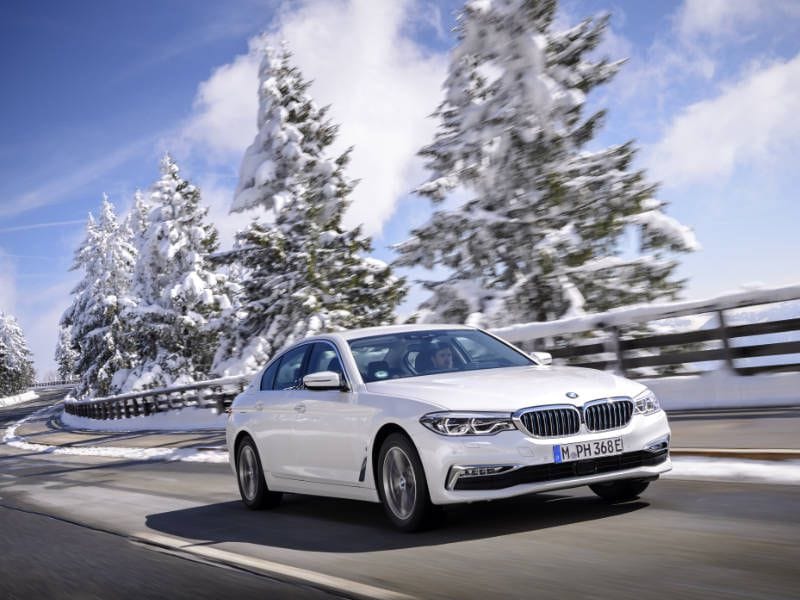
2018 BMW 530e iPerformance hero ・ Photo by BMW
BMW may be better known for its performance cars, sports sedans and diesels, but the German luxury automaker is also in the hybrid business. In fact, the company says it’s now the third-largest maker of electrified cars in the world. BMW’s newest hybrid is this 2018 530e iPerformance. It’s a plug-in hybrid version of the hugely popular 5 Series mid-size luxury sedan and it just may make you forget about that Tesla Model S you’ve been dreaming about.
Although hybrids and electric vehicles remain a small percentage of all new car sales, BMW has created a full lineup of electrified cars over the last few years. BMW’s long list of plug-in hybrids now includes the exotic i8 supercar that costs about $150,000, the quirky i3 hatchback and many hybrid versions of the automaker’s mainstream models, including electrified versions of the 3 Series and 7 Series sedans and X5 SUV. Well, now you can add the 5 Series to that list.
Much Cheaper Than a Tesla
Built in Germany, the 2018 BMW 530e iPerformance sedan slots between the 530i and the 540i in the extensive 5 Series lineup. Prices start at $53,395, including $995 for destination, for the rear-wheel drive model. BMW’s xDrive all-wheel drive system is offered for an additional $2,300. Although that’s $6,800 more than a smaller BMW 330e iPerformance, it’s only $1,200 more than an equivalent gas-only 530i. It’s also about $16,000 less than the base price of the rear-wheel drive Tesla Model S 75 model.
Inside, buyers get standard navigation with a massive 10.2-inch touchscreen, Bluetooth, a sunroof, a 12-speaker sound system, wood trim, dual-zone automatic climate controls, a rear-view camera and a power adjustable driver’s seat. Standard exterior features include 18-inch wheels with run-flat tires, LED headlights and black chrome exhaust tips.
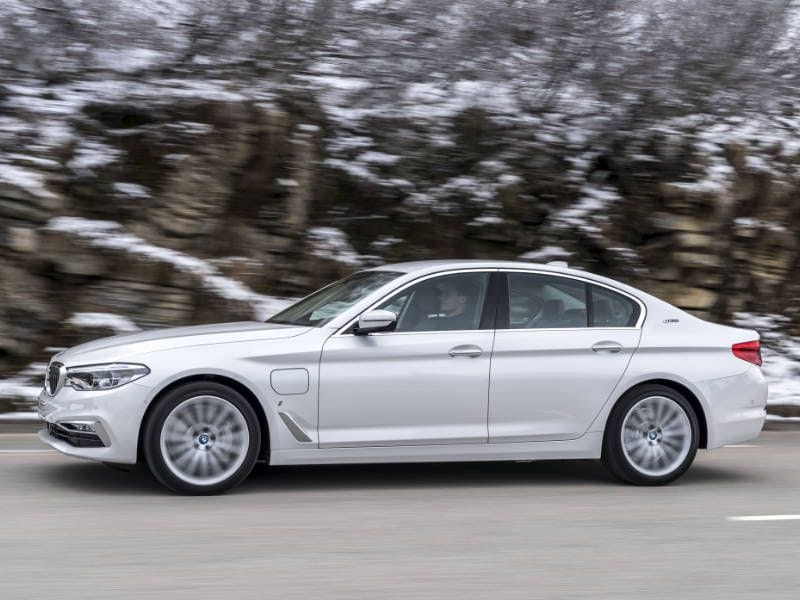
Photo by BMW
Packs a Combined 248 Horsepower
Powering the 2018 530e is BMW’s plug-in eDrive system, which is also used in the 3 Series, 7 Series and X5. It combines a turbocharged and direct-injected 2.0-liter four-cylinder gas engine with an electric motor and a small 9.2-kWh lithium-ion battery pack mounted behind the rear seat. In the 530e sedan, the engine is rated 180 hp but the electric motor adds 111 hp, for a combined output of 248 hp. That's quite a bit less than you get in the larger and heavier 740e iPerformance sedan but it matches the system’s output in the smaller 330e.
BMW has also placed the electric motor upstream of the standard eight-speed automatic transmission so its gear ratios are used even in all-electric mode. It’s a clever bit of engineering and gives the 530e a very different feel than other EVs like a Tesla Model S. Even in all-electric mode it feels more like a conventional BMW sport sedan.
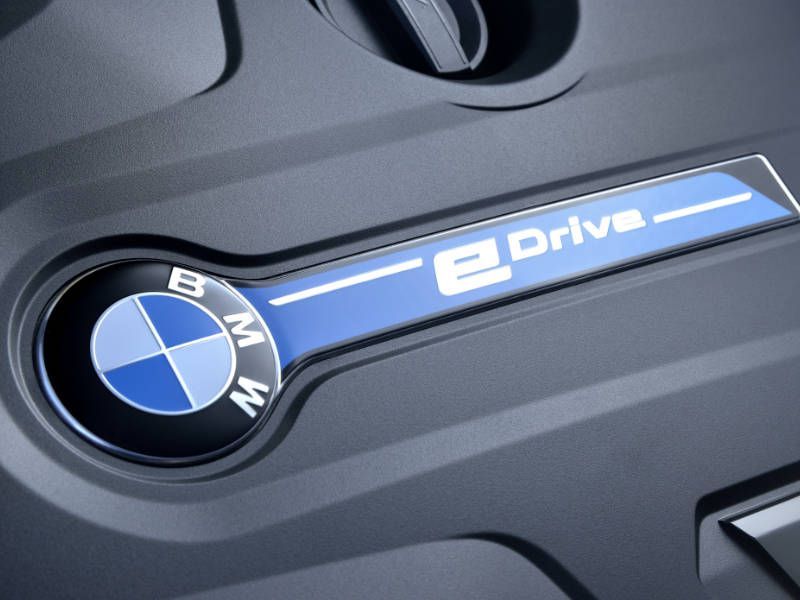
Photo by BMW
31 Miles of Electric Range
If your commute is short enough and you keep your throttle inputs under control, the BMW’s gasoline engine should never turn on and the new 530e would function as a pure electric vehicle indefinitely. The sedan will travel about 30 miles on electric power alone up to speeds of 87 mph. This is impressive, as the EV range of both the Mercedes-Benz S550e and the BMW 740e is just 14 miles. However, the less expensive Chevrolet Volt plug-in can be driven about 50 miles on electric power alone.
The total range of the 2018 530e is about 400 miles, and of course most of that is achieved by burning a combination of gasoline and electricity. If you floor the gas pedal the BMW’s 2.0-liter will turn on to add power, but the turbo engine turns on and off so smoothly you don’t feel the transition.
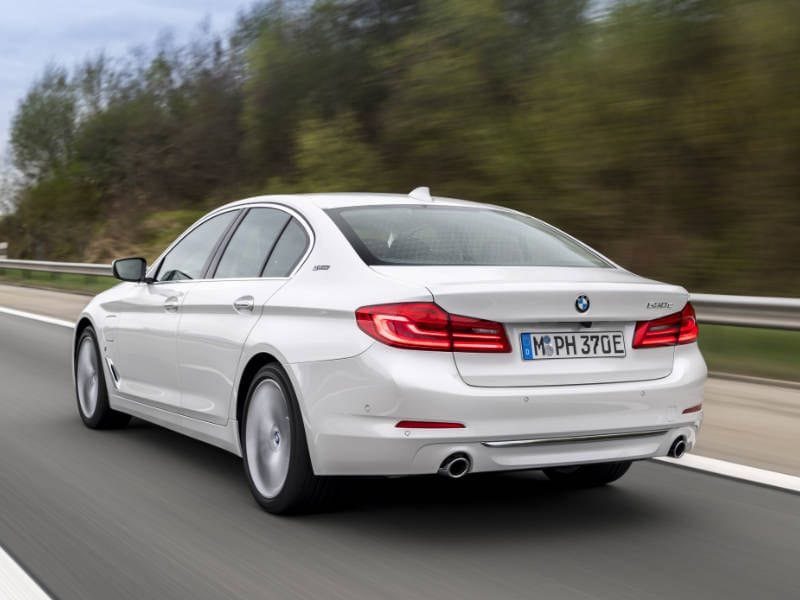
Photo by BMW
Driver Can Select Among Three Operating Modes
The BMW 530e iPerformance goes about its business so smoothly and seamlessly, most of the time you would never know it has two powertrains working together to get you down the road. However, with the eDrive button on the console, you can toggle among several settings to control the interaction between the engine and electric motor depending on the driving environment.
Auto eDrive is the default mode, allowing the sedan’s computer systems to optimize fuel efficiency and power delivery depending on speed, throttle position, road conditions and many other data points. The other two settings allow you to dial in or out the involvement of the electric motor or the gasoline engine. Max eDrive is maximum electric power only, but the gas engine will fire if you press through a detent in the throttle’s travel. Battery Control mode saves the battery charge for later to a determined level, or even charges the batteries as you drive.
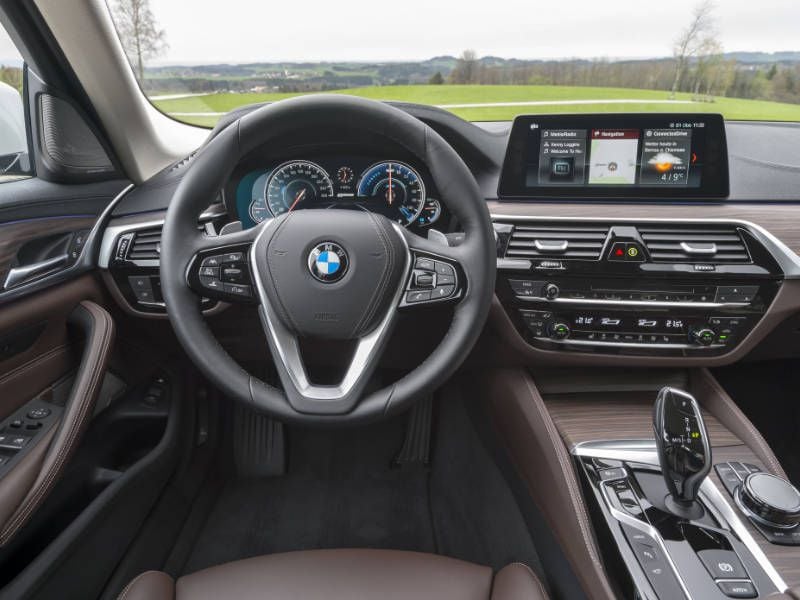
Photo by BMW
Easy to Drive
Just like in every other BMW sedan, BMW’s Driving Dynamics Control allows the driver to choose among three settings: Comfort, Sport and Eco Pro, which is the default setting in the 530e. Each changes the readiness and involvement of the gas engine. In Sport, the engine is always adding power. Use the standard paddle shifters and the eight-speed automatic transmission matches revs on the downshifts just as it does in a gas-only 5 Series.
I was also pleasantly surprised by the 530e’s lack of hard regenerative braking like you’ll find in most electrified cars, including the Tesla and the Cadillac CT6 plug-in. Come off the throttle and the 530e coasts freely, just as you would expect in a gas-only 5 Series. In city driving, this keeps the BMW from feeling like a luxurious golf cart. The hybrid system still harnesses the energy created by the brake system and sends it to the battery pack mounted under the rear seat; it just accomplishes this without intruding on the driving experience.
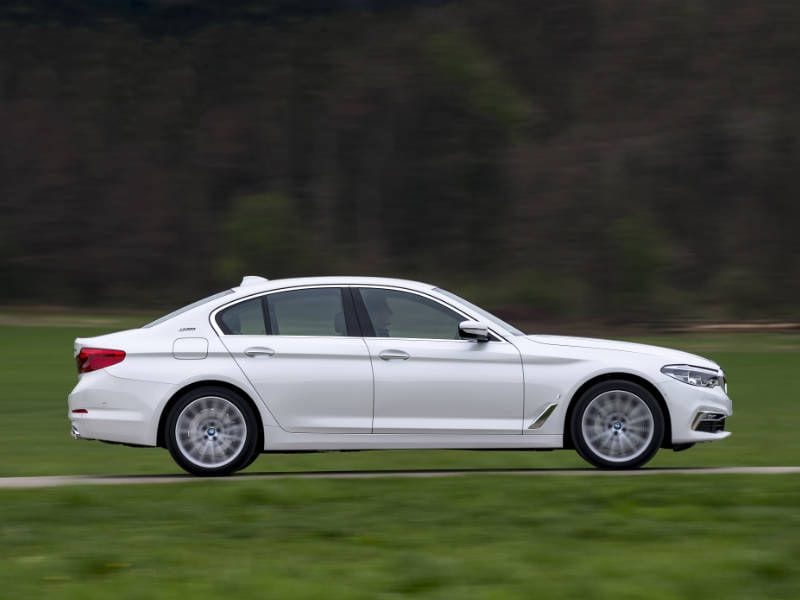
Photo by BMW
Performs Like a Proper BMW
BMW claims a 0-60 mph acceleration performance of just 6.0 seconds. Although that’s quite a bit slower than the Tesla, it’s the exact same number BMW claims for the rear-wheel drive 530i. The 530e’s top speed is equally impressive at 146 mph.
Although weight has increased to 3,900 lbs, the additional 150 pounds isn’t a problem. In fact, it lowers the sedan’s center of gravity and its balance is improved because much of that additional weight is mounted in the rear of the car. The ride is comfortable, and handling is more than acceptable for most buyers. In Sport mode on twisting secondary roads north of Los Angeles, the 530e was entertaining and quick, with plenty of grip and steering feel. And out on the highway, it showed impressive passing power and high-speed stability.
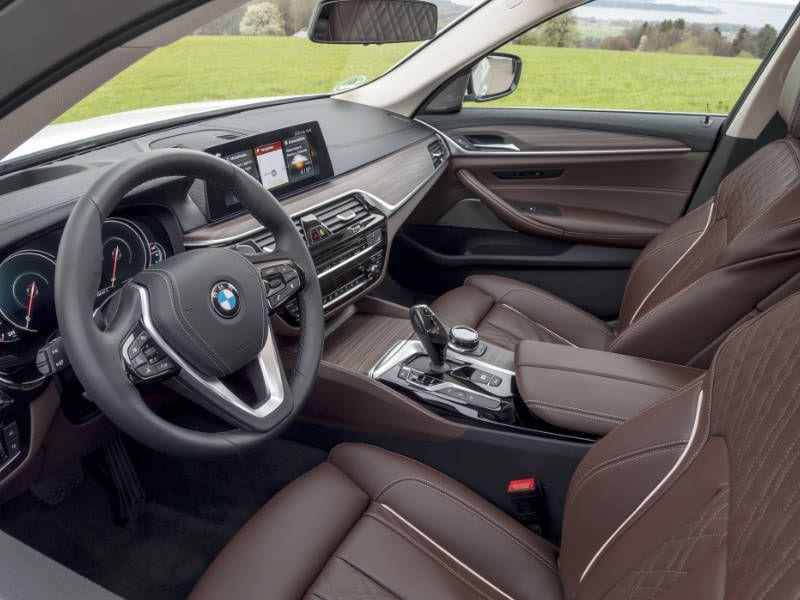
Photo by BMW
Recharging Takes Just 3.0 Hours
Charging the BMW’s 9.2-kWh lithium-ion battery pack is as easy as plugging in your laptop. The sedan’s battery system can be charged in under five hours on a standard 110v wall socket and approximately 3.0 hours using a 220V charger. Located on the left front fender, the sedan’s charge port mimics its traditional gas filler door, which remains on its right rear quarter panel. Its addition doesn’t spoil the 5 Series' lines enough to be a problem, but the lack of symmetry between the left and right side of the car may bother some.
Although wireless charging is part of the optional Premium Package, the charging pad itself is still in the prototype stage of development. When it is available, and BMW says it will be approved for production soon, owners will park their 530e sedan over the pad, which generates an alternating magnetic field with a secondary coil housed in the underside of the car. The two never touch. BMW says the system can be installed indoors or out and the charging time is about 3.5 hours.
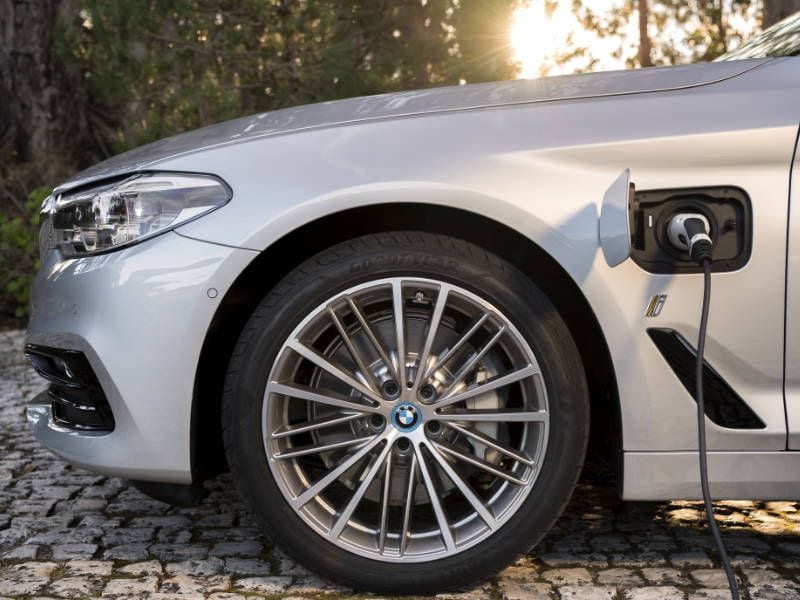
Photo by BMW
Big Safety But a Smaller Trunk
Every safety system available on the standard 5 Series is offered on the 530e, at least in expensive option packages. This includes cross-traffic warning, a lane change assistant and active lane change warning, which will steer the vehicle for you to help avoid an accident. Adaptive cruise control is also an option, along with blind-spot alert and a pre-collision system with pedestrian detection that warns if vehicles and pedestrians are in your path. It will also automatically begin braking in a low-speed situation if the system believes an accident is imminent. BMW also offers optional side- and top-view cameras that provide a detailed overhead bird’s-eye view of the vehicle and its surroundings.
Unfortunately, the BMW’s battery pack does intrude into the sedan’s trunk space. Don’t worry, your golf bag will fit, but cargo volume drops from 18.7 cubic feet in the 530i to 14.5 cubic feet in the 530e. The good news is that’s still more than you get in a standard 3 Series, and BMW managed to retain the split 40/20/40 folding rear seat, which is rare in hybrid sedans.
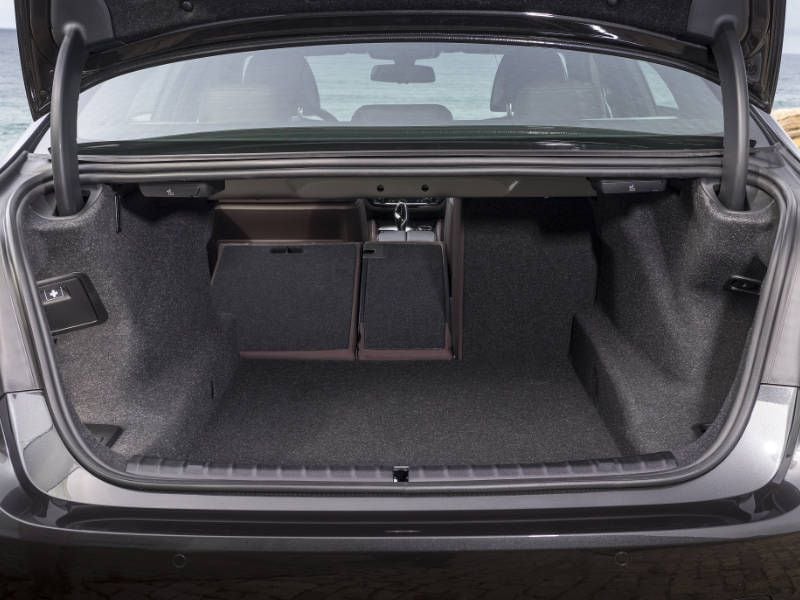
Photo by BMW
Good Value
Mercedes-Benz and Audi still don’t offer plug-in hybrid versions of the E-Class and A6 so the 530e will enjoy little competition for a while. Plus, other luxury four-door hybrids are far more expensive. The Cadillac CT6 costs $75,095, the Mercedes S550e costs $115,525 and the Porsche Panamera E-Hybrid is about $100,000.
The 2018 BMW 530e iPerformance is luxurious and it performs well — few hybrids are this fun to drive. Its interior is also beautifully appointed and extremely comfortable. If you’re looking for a luxury plug-in hybrid sedan, the 530e is a very compelling overall choice.
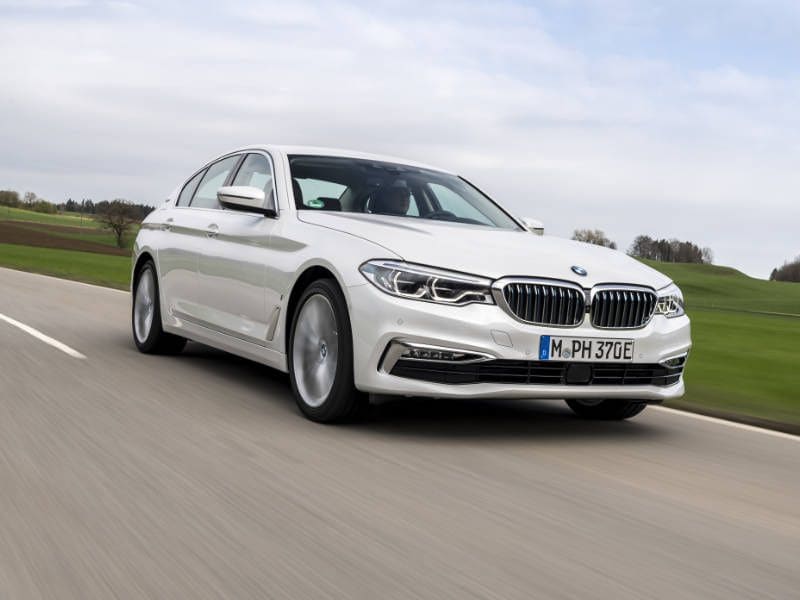
Photo by BMW